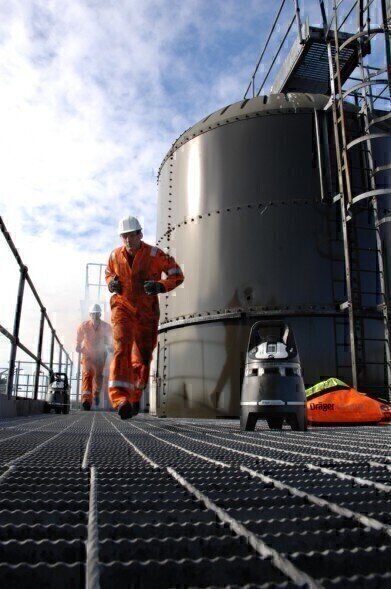Gas Detection
Tackle Offshore Hydrocarbon Dangers with Wireless Safety Net
Dec 09 2010
With the release of Health and Safety Executive (HSE) statistics showing an increase in major injuries and unplanned hydrocarbon releases offshore in 2009/10, there has never been a better time to establish a wireless safety net to ensure reliable gas detection. By operating as an all-round safety network, the new X-zone 5000 from Draeger (UK) uses wireless technology to automatically connect multiple monitors for reliable, continuous detection of hydrocarbons, hydrogen sulphide and oxygen depletion.
Ensuring that personnel have the confidence to work worry free, even in the most dangerous environments, these transportable units are quick to deploy and easy to set up. Issuing a loud alarm as soon as a gas is detected, they also change colour to clearly identify the alarm status. The areas where gas has been detected are indicated by red visual alarms. Safe atmospheres and, therefore, a safe escape route are confirmed by green visual alarms.
Warning the offshore oil and gas industry about its safety record, the HSE reported that out of 443 dangerous occurrences, 42% of those related to hydrocarbon releases. It also showed a marked rise in the combined number of major and significant hydrocarbon releases, regarded as potential precursors to a major incident.
By simply placing Draeger X-zone 5000 units around potentially dangerous areas or where maintenance or shutdown work is being carried out, these robust, waterproof units will ensure increased levels of safety in any offshore application. As soon as one of the units detects a gas it immediately transmits an alarm to each of the others, warning everyone in the area that a danger exists. At the same time, a loud evacuation alarm is emitted and a patented 360º alarm amplifier ensures that it is heard with the same intensity in all directions.
Up to 25 Draeger X-zones can be used at any one time, forming a complete wireless network to suit the specific application, including those where an explosion hazard might exist. In addition to this Zone 0 ATEX performance, they also offer a lower cost of ownership by combining flexible monitoring capabilities with a long sensor life and enhanced battery performance.
Allowing gas ingress from every side, it can be fitted with up to four sensors to detect as many as five gases at once. The Drager X-zone 5000 provides simultaneous measurement of gases and vapours such as hydrocarbons, hydrogen and other explosive, combustible or toxic gases.
Unlike portable instruments which usually leave the scene with the wearer, the Draeger X-zone 5000 can be left in situ for up to 120hours continuous operation, issuing an alarm as long as the danger exists.
Digital Edition
IET 34.2 March 2024
April 2024
Gas Detection - Biogas batch fermentation system for laboratory use with automatic gas analysis in real time Water/Wastewater - Upcycling sensors for sustainable nature management - Prist...
View all digital editions
Events
May 05 2024 Seville, Spain
May 06 2024 Minneapolis, MN, USA
May 13 2024 Munich, Germany
May 15 2024 Lund, Sweden
May 15 2024 Frankurt-am-Main, Germany


















